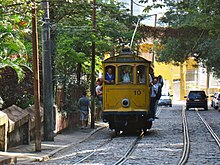Santa Teresa Tram

Tram on cobblestone-paved section of Rua Joaquim Murtinho in 2009
|
|||
| Operation | |||
|---|---|---|---|
| Locale | Santa Teresa, Rio de Janeiro, Brazil | ||
| Open | 1877; electric 1896 | ||
| Status | Open | ||
| Routes | 1 | ||
| Operator(s) | Companhia Estadual de Engenharia de Transportes e Logística | ||
| Infrastructure | |||
| Track gauge | 1,100 mm (3 ft 7 5⁄16 in) | ||
| Electrification | 600 V DC, overhead wire | ||
| Statistics | |||
| Route length | 6.0 kilometres (3.7 miles) (currently limited to 2.0 km or 1.2 mi) | ||
|
|||
The Santa Teresa Tram (Portuguese: Bonde de Santa Teresa, IPA: [bõˈdʒi dʒi ˈsɐ̃tɐ teˈɾezɐ]) is a historic tram line in Rio de Janeiro, Brazil. It connects the city centre with the primarily residential, inner-city neighbourhood of Santa Teresa, in the hills immediately southwest of downtown. It is mainly maintained as a tourist attraction and is nowadays considered a heritage tramway system, having been designated a national historic monument in 1988. The line has a very unusual gauge: 1,100 mm (3 ft 7 5⁄16 in). The main line is 6.0 kilometres (3.7 miles) long.
Having run continuously since its opening in 1877 (except for a 2011–15 suspension), it is one of the oldest street railway lines in the world and having been electrically powered since 1896, it is the oldest electric railway in all of Latin America. It is also the only remaining metropolitan tram system in Brazil. The only other original tram systems in the country to have survived past 1971 are the Campos do Jordão interurban tram/light rail line and the Itatinga line (near Bertioga), a rural and non-public tram line, which both continue to operate today. All other cities closed their systems by 1971 (Santos being the last), but since that time, three towns, Belém, Campinas and Santos, have reinstated trams as heritage services, and Rio de Janeiro opened a modern light rail/tram system in 2016.
...
Wikipedia

